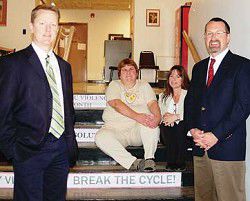Local programs aim to ‘stop the hurt’
Published 5:00 pm Tuesday, October 14, 2008

- Raising awareness about Domestic Violence in the county are, from left, District Attorney Ryan Joslin, Victim Intervention Specialist Teresa Cowing, safety audit coordinator Pam Fisher and - newly returned - Deputy District Attorney Colin Uhrick. <br>The Eagle/Angel Carpenter
CANYON CITY – “Nobody wants to talk about domestic violence,” said Pam Fisher, “because it’s shame-based, and it cycles in families for generations.”
Trending
Fisher, who is the safety audit coordinator for the Grant County District Attorney’s Victim Assistance office and is a domestic violence investigator, and her co-workers at the Grant County Courthouse recognize October as Domestic Violence Awareness Month – a national movement created by the federal Office on Violence Against Women.
Fisher would like to see a change to a zero-tolerance level for domestic violence and family violence, much like the movement that Mothers Against Drunk Driving (MADD) created for its cause.
She said most people who see a drunk driver on the road wouldn’t hesitate to call. She wants the community to have the same attitude toward domestic violence.
Trending
She said that “it is scary to call, but the consequences of not calling could be deadly.”
“Three women in the nation are killed each day through acts of domestic violence,” she noted.
Also, living with violence “actually alters the brain chemicals in children. Long-term research is showing they have more stress disorders.”
This affects not only their behavior at home, but also in class – “they’re tired when they come to school,” she said.
Ninety percent of domestic violence is perpetrated by men; however, the office does occasionally, including recently, see cases where women are the offenders.
Deputy District Attorney Colin Uhrick who prosecutes domestic violence cases for the county said that when a victim of domestic violence calls, it “sets into process a pretty big machine.”
But there are new programs designed to help end the hurt.
Last summer, Uhrick made significant changes to the domestic violence diversion program including dropping an anger management program and requiring a more intensive batterers intervention program (BIP).
Uhrick said they work closely with community partners such as Oregon Life Solutions – which runs the BIP – to make sure accused abusers are following through, and being held accountable.
“It’s to help people make positive changes in their lives as opposed to spending a couple days in jail,” he said. “The goal is to interrupt the cycle of violence and help batterers learn new skills – to learn about the cycle and recognize these traits in themselves.”
The process requires probation for a period of time and a batterers intervention program and may include alcohol and drug treatment or mental health therapy, if needed.
If the abuser follows through, the charge is dropped from their record – on the other hand, “if they don’t follow through on the conditions of their diversion program or probation, they’ll be brought back in front of the judge for further consequences.
Another new program which started last spring allows the victim to learn new skills as well. If the survivor doesn’t have access to health insurance or is unable to pay for counseling, grant funds may be applied for through the victim assistance office, allowing them to choose their own counseling service.
From Oct. 1, 2007 to Oct. 1, 2008 there were 20 cases of domestic violence in the county with seven prosecuted. Of the seven prosecuted cases, 10 minors were present. There were 13 restraining orders issued with two dismissed.
Recently three more cases of domestic violence were brought to their office.
The minute charges of domestic violence are brought against a person, the survivor is contacted by the victim assistance office.
Victim intervention specialist Teresa Cowing is on the front line, helping survivors.
She said that while there is no excuse for domestic violence, “typically financial issues are the biggest thing that people fight about.”
“When the mills have issues, verbal (abuse) goes up,” she said.
Step-parenting issues are another big one.
Typically the survivors “justify everything,” she said. “‘If I had just had dinner done’ or ‘If the kids had their toys picked up,'” are comments she often hears.
Cowing usually sees women walk in the door with a chip on their shoulder, saying, “You have no idea.”
Yet, she does know something of dealing with violence at home.
She was in an abusive relationship years ago when one of her sons was 3 years old.
At the time of the abuse she thought her son, who is now an adult, had been shielded – too young to know what was happening and the children were in their bedrooms when fighting occurred – however, she recently discovered that he recalled in detail things that happened and that he’d been “holding it inside” all these years.
Cowing said the best thing for people to do is call 911 if there is physical abuse happening, especially if there are children involved.
“We’ve had cases where kids have gotten hurt. They try to get in the middle.”
“It’s really important for people to understand that the children can get hurt.”








